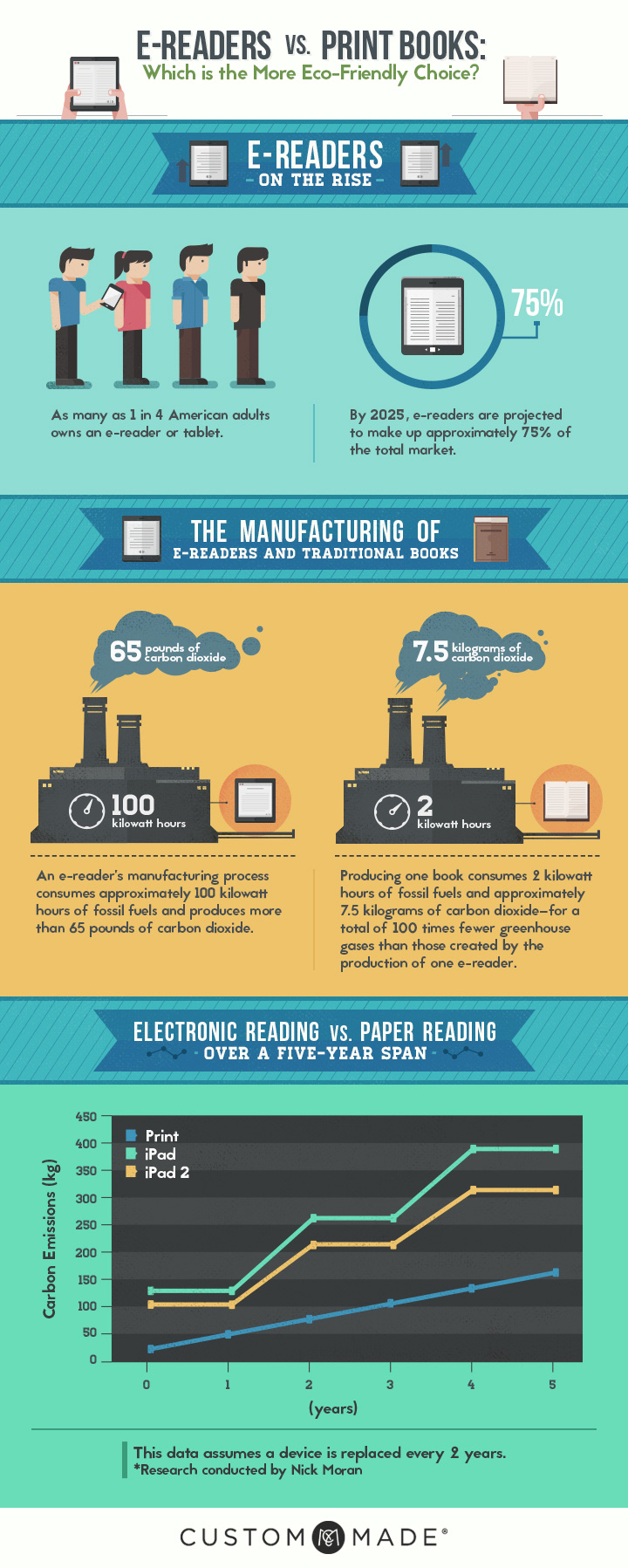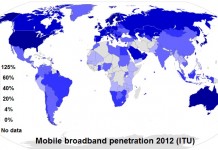CustomMade, a platform that focuses on putting together individual custom-makers with consumers, has just shared an infographic comparing the ecological benefits and footprint of e-readers versus traditional print books. In their own context, this could be about persuading people that the venerable bookshelf is not such an ecological burden as it might at first seem. And their feature breaks down the whole argument in very detailed terms, and is worth scanning. But they’ve also distilled it into a neat infographic, which even if it does some strange moves like contrasting pounds and kilos of carbon, is well worth perusing. Enjoy.


































They seems to have overlooked the CO2 emissions attributable to logistics. I live in New Zealand. When I used to buy dead tree books from Amazon they were air freighted from a well lit air conditioned warehouse to New Zealand and delivered by a courier. Not I just transfer bits across the internet at a significantly lower cost for the book and the freight charge which used to be a 30 or 40% plusage is now zero. Moving bits not atoms is a simple obvious path to lower carbon emissions. I also wonder if they accounted for the fact that the trees that are felled to make books would otherwise have gone on absorbing CO2 from the atmosphere. A recent article pointed out that trees are the best form of geo-engineering we currently have to fight climate change.
http://www.theatlantic.com/technology/archive/2015/02/the-best-technology-for-fighting-climate-change-trees/385304/
I’m not getting the math – The ereader consumes 50 times more electricity than a book and 4.5 times the CO2 – so if I read more than 50 books in 2 years, doesn’t that make the ebooks more efficient?
@dbr You’re not supposed to do the math, you’re just supposed to accept the skewed data. The middle graphic appears to be comparing a dedicated e-ink reader to a single paper book, the data indicates that if you read 5 books a year your carbon footprint is better on e-ink but that’s not how they’re trying to present it. (it also ignores distribution)
The bottom graphic is comparing an iPad and iPad2 carbon footprint to paper books. It’s showing 105 kg and 130 kg for each device which is much higher than the 29.5 kg used in the middle graphic. It’s also assuming that the only reason you’re using the iPad is to read books and also ignores distribution.
As it is written, this infographic seems designed to confuse rather than to inform. Lets note. 1. They provide data in different units — 65 pounds of CO2 vs 7.5 kg. Since converting is literally as easy as multiplying or dividing by 2.2, why not use the same unit of say 65 lbs vs 16.5 lbs? 2. They draw a conclusion that is not supported by the data. There is no math in the world that supports the conclusion that 50 times as much fossil fuel and 4 times as much CO2 results in 100 times as much green house emissions.
Actually when I read the article and tracked it back to their source, I see that part of the problem is that they are pulling data from different sources.. and are then comparing apples to oranges. The 65 lbs of CO2 is the total green house gas produced in manufacturing an ebook reader. The 16.6 lbs of CO2 is the cost of manufacturing, delivering to a store and purchase of a paper book.. then they jump back to comparing just the energy of production which they still get wrong.. since it should be 50 times, not 100 times. When we include the cost of delivery to the store and buying from the store the paper book really starts to look bad … even if we allow similar carbon footprint for delivery and purchase of an e-reader (reasonable since they are about the same size and weight in broad terms), it is clear that the total carbon footprint of the e-reader is maybe 5 times as great. Even if I make some very big assumptions (ones I know are probably too high by an order of magnitude) about the amount of energy required to deliver an ebook and charge the reader, I can’t find a way to get the break even point any higher than about 10 books.
Oh… umm.. I just noticed something else, the last chart, that plots carbon emissions over time estimates 150 kg over 5 years for paper books.. or about 4 books a year using their estimate of 7.5 kg of carbon per book. And if we use the actual carbon footprint of a dedicated e-reader (as opposed to iPads), and replace it every 2 years, we are at 195 kg of carbon at the end of 5 years… and does anyone think that someone who only reads 4 books a year is going to replace their e-reader every 2 years? If we assume 10 books a year instead, the paper book reader will have increased their carbon footprint by.. 375 kg.
Oh, here is another thought, based on some links in the original article, by far the least efficient part of a paper book is going to the book store to pick it up. Based on that article, I estimate that of the 7.5 kg of carbon, 6.25 comes from driving to the bookstore and back. So, even if you get your books from a used book store or a library, you are not actually reducing the impact of the book by all that much.
I read something like 200 books a year. On an old iPod a friend gave me. That I have used for years and have no plans to replace. I can hold it in one hand and read it lying down. It’s backlit, so I can turn off the bedroom light and read myself to sleep. I fall asleep, the iPod (in its protective rubber skin), tumbles onto the bed and turns itself off.
The only environmental cost associated with the iPod, after the initial manufacturing and shipping costs, is the daily recharge. Which probably does not take that much more electricity than the lightbulb I am not using.
Reading is not eco-friendly. Period.
🙂